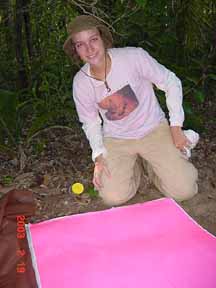 |






|
 |

 |
 |
 |
 |

Natalie, a researcher, next to her invention, a track trap that doesn't wash away. |
 |
 |
 |
Track Traps
Peter and Susan
One of our goals for this trip to the Pantanal is to start a track trap project that we can field test here and continue with a sister project along the Assabet River near Hudson High School. Upon our arrival, we were excited to discover that Natalie, a guest researcher here for this week, is conducting her own project to compare two different track trap designs. We went along with Natalie to see her track trap system at work.
Natalie may be soft-spoken but she has a big idea. Natalie is a biologist developing a new method of track traps, a method used in research to identify animals. Traditional track traps are made with mud or sand and baited with food or scented lures. Natalie's method uses a unique sheet of plastic that records the track or print of an animal on its surface rather than a three-dimensional print in mud or sand. There was a rainstorm today and I saw how traditional traps are at a disadvantage because the tracks had been distorted or washed away. Natalie's method held up to the rain!
I went along with Natalie and her group to see how the traps were set. In her study, Natalie places a traditional track trap alongside her new method in order to compare data and limit variables. She says that if an animal walks on one trap they walk on the other, too. Then Natalie can compare the quality prints and identify animals from each track-taking method.
I asked Natalie how she came up with the idea of the plastic track recording material.
She smiled brightly and said, "When I was a kid, I had a toy that I used to draw on and that is where I got the idea." I thought that was quite smart.
Natalie works at the University in Rio de Janeiro, Brazil. Presently they are partnering with a team of biologists: Vitor, Diogo, and veterinarian Tatiana studying small mammals in the Pantanal. Vitor, Tatiana, and Diogo are diagnosing and monitoring wildlife health here.
So what animals has she identified while working with track traps? She has made plaster casts as well as traced paw-print sketches of the crab-eating fox, agouti, bush dog, and ocelot. On the rounds to the traps, I saw a family of peccaries, a feral pig, two marsh deer, three agouti, toucans, southern screamers, two caracaras, a group of chaco chachalacas, and many more birds.
We are planning to set up our own traditional traps and make more plaster casts of the tracks here, too. I dream of finding prints of a jaguar in one of these traps! And when we return to Hudson, we will try out both methods. We wonder if the plastic will work equally well in somewhat colder temperatures.
For more information, click on the Hudson School site.
Photo
courtesy of Earthwatch
Institute
|
 |
 |
|
|
|
 |

